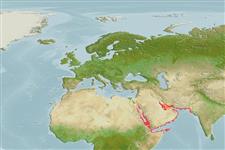Common names from other countries
Environment: milieu / climate zone / depth range / distribution range
экология
морской ассоциированный с рифами; пределы глубины 5 - 50 m (Ref. 89707). Tropical; 29°N - 10°N, 32°E - 68°E (Ref. 5222)
Western Indian Ocean: Red Sea (including Gulf of Suez) and northwestern Indian Ocean to the coast of Pakistan. Specimens examined include those from the Gulf of Oman. Not reported from the Gulf of Aqaba nor from Persian Gulf.
Size / Вес / Возраст
Maturity: Lm ? range ? - ? cm
Max length : 38.0 cm TL самец/пол неопределен; (Ref. 89707); common length : 35.0 cm TL самец/пол неопределен; (Ref. 5450)
колючие лучи спинного плавника (общее число) : 11; членистые (мягкие) лучи спинного плавника (общее число) : 16 - 18; колючие лучи анального плавника: 3; членистые (мягкие) лучи анального плавника: 8. Body robust, preopercle with moderately enlarged serrae at its angle; upper edge of the operculum almost straight; nostrils subequal or posterior nostril slightly larger. Head and body yellowish gray, with dark orange-red or reddish brown spots except ventrally and posteriorly; dark gray bars running antero-ventrally from the base of the dorsal fin; a dark saddle blotch on the caudal peduncle. Fins generally yellowish brown; median fins with broad yellowish margin posteriorly (Ref. 89707).
Occurs on shallow sandy bottoms near small coral heads; it is not known from well-developed coral reefs (Ref. 5222). Nothing has been published on its biology nor its use in fisheries (Ref. 5222). Sold fresh in local markets (Ref. 5222).
Life cycle and mating behavior
Maturities | размножение | Spawnings | Egg(s) | Fecundities | личинки
Heemstra, P.C. and J.E. Randall, 1993. FAO Species Catalogue. Vol. 16. Groupers of the world (family Serranidae, subfamily Epinephelinae). An annotated and illustrated catalogue of the grouper, rockcod, hind, coral grouper and lyretail species known to date. Rome: FAO. FAO Fish. Synop. 125(16):382 p. (Ref. 5222)
Статус Красного Списка МСОП (Ref. 130435)
CITES (Ref. 128078)
Not Evaluated
Угроза для людей
Harmless
Использование человеком
рыболовство: не имеет хозяйственного значения
дополнительная информация
инструменты
Специальные отчеты
Скачать в формате XML
ресурсы в Интернет
Estimates based on models
Preferred temperature (Ref.
115969): 25.4 - 29.4, mean 27.9 (based on 142 cells).
Phylogenetic diversity index (Ref.
82804): PD
50 = 0.5000 [Uniqueness, from 0.5 = low to 2.0 = high].
Bayesian length-weight: a=0.01175 (0.00571 - 0.02419), b=3.04 (2.88 - 3.20), in cm Total Length, based on LWR estimates for this Genus-body shape (Ref.
93245).
Trophic level (Ref.
69278): 3.7 ±0.6 se; based on size and trophs of closest relatives
устойчивость к внешним воздействиям (Ref.
120179): средний (среднего размера), минимальное время удвоения популяции 1.4-4.4 года (Preliminary K or Fecundity.).
Fishing Vulnerability (Ref.
59153): Low to moderate vulnerability (28 of 100).
